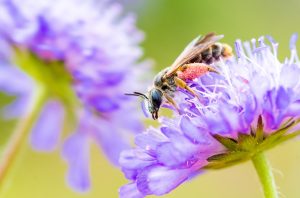…blog by Alice Parfitt, Buglife Changing Chalk Conservation Officer, written for Solitary Bee Week 2023
The flower rich chalk grassland of the South Downs is home to a wide range of solitary bees and bumblebees including some very rare species. However, we have lost over 97% of flower-rich grassland in the UK since the 1930s, and the remaining habitat available for bees to feed and nest has become fragmented and isolated making it difficult for some species to survive. The Changing Chalk project is a partnership of organisations working together to restore and enhance the chalk grassland of the Eastern South Downs for the benefit of all wildlife, including some of our rare and threatened bees that call this area home.
This solitary bee week we’ll spotlight just a few of the rarer species you might find on the chalk grassland of the Changing Chalk project area.
The Potter Flower Bee (Anthophora retusa) is one of the UK’s rarest bees and is now confined to just a few sites along the south coast of England. Within the project area they are found on chalk grassland sites where they can forage, with areas of soft rock cliffs or sandy deposits at cliff faces for nesting. They are a spring flying species, but care is needed in identification as the females in particular are very similar to the much more common Hairy-Footed Flower-bee (Anthophora plumipes) that you might see in your garden.

Another spring flying species is the Red-tailed Mason Bee (Osmia bicolor) also sometimes called the Two-coloured Mason Bee. This is an attractive bee; the female has a black head and thorax with a bright orangey red abdomen making her very distinctive. The males, however, are a brownish grey colour with slightly redder tails and are less easy to distinguish from other closely related species. This is primarily a species of chalk and limestone grasslands, though it can turn up in other habitats too but is a distinctively Southern species. The Red-tailed Mason Bee along with a few related species makes its nest in empty snail shells, preferably on warm south facing slopes. Once an egg is laid, each cell is sealed with a layer of chewed up leaf mastic. Once the shell has 4 or 5 cells completed, the female collects grass stalks to make a wigwam over the shell, presumably to camouflage it. Often the females are first seen when they are in flight carrying these long bits of grass – keep an eye out for this if you are visiting chalk grasslands in the spring.
The Downland Furrow Bee (Halictus eurygnathus) is a real Changing Chalk area specialist. It was formerly recorded from East Sussex, Kent, Dorset, and the Isle of Wight but went un-recorded for many years. It was then ‘re-discovered’ on the South Downs of East Sussex about 20 years ago and this is now its UK stronghold where it can be abundant on some sites. This bee can be on the wing from mid-May into September and collects pollen from Greater Knapweed (Centaurea scabiosa) but can also be found nectaring on scabious flowers once the knapweed has gone over. It nests in the light soils of the chalk grassland. If you want to look for it, check out any south facing slopes with plentiful Greater Knapweed on the South Downs between Lewes and Eastbourne.

The final species we’re going to take a look at can also be found when the scabious are in flower is the Large Scabious Mining Bee (Andrena hattorfiana). They are on the wing from late June to about mid-August and the females are fairly recognisable in the field. They are about honeybee size and as they collect pollen from Field Scabious (Knautia arvensis), are often found on these flowerheads with the pink pollen attached to their hind legs making them very distinctive. Any areas of chalk grassland where there is abundant Field Scabious can be a good spot to try and find them.
While these are some of our rarer bees that are found in the Changing Chalk project area, there are still lots of opportunities to look out for some of our more common solitary bees. The best place to look are any areas of flower rich grassland as bees will be visiting flowers to collect pollen and nectar. You might be able to spot a nesting aggregation in bare or sparsely vegetated ground – a naturally occurring bee bank on chalk grassland can be a great place to see bees busily going about their business. Some species nest very closely together so can be very obvious though others can be much more discreet.
Landscape for Wild Pollinators is part of the Changing Chalk partnership, led by the National Trust and funded through the National Lottery Heritage Fund, Peoples Postcode Lottery and Sussex Community Foundation. If you think you have seen any of these species or would like to get involved with any of our survey work for these species, please do get in contact.
Join us & celebrate the wonderful world of solitary bees!
90% of bee species are solitary bees and along with other pollinating animals their hard work is responsible for at least one in every three mouthfuls we eat. However, like many species, they are under threat and need our help.
We invite you to Earn Your Stripes by pledging to help the bees, Wear Your Stripes for a day, or the entire week, and Share Your Stripes by helping us to raise awareness and share your activities, solitary bee facts and photos across your socials this Solitary Bee Week
Find us on
Facebook, Instagram & LinkedIn
Tag us and share your solitary bee journey using the hashtags #SolitaryBeeWeek | #WearYourStripes | #ShareYourStripes | #EarnYourStripes

